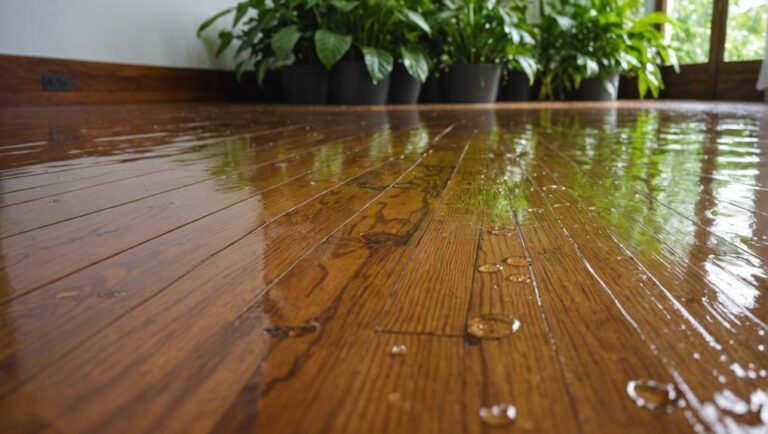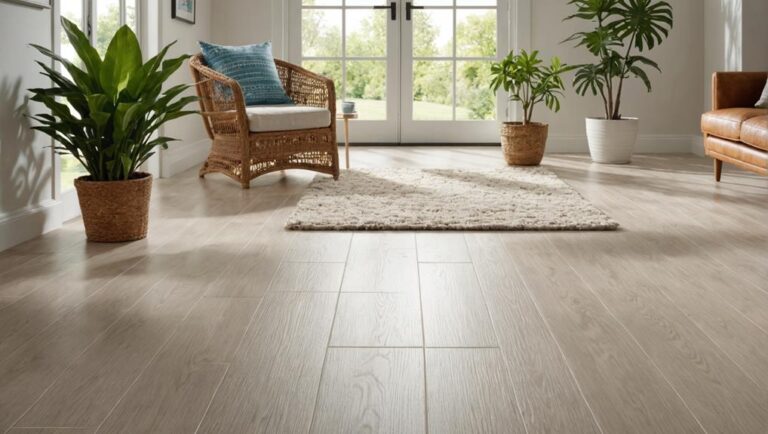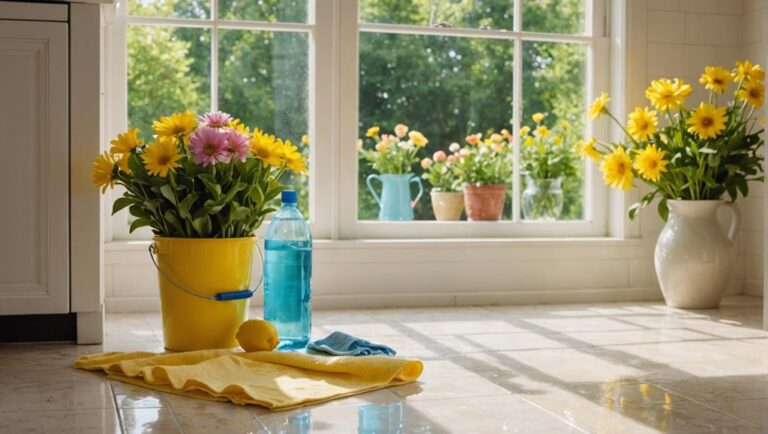To install vinyl plank flooring, begin by preparing the subfloor. Clean it well, address any issues, and make sure it’s level. Lay down the underlayment flat, trim excess, and secure it properly. Take time to acclimatize the flooring, start with a snug first row, and use spacers for gaps. Cut planks precisely and stagger seams for stability. Finish by applying sealant for protection and clean regularly for maintenance. Following these steps will lead you to a successful vinyl plank flooring installation. More tips await to guarantee your project’s success.
Tools and Materials Needed
When starting your vinyl plank flooring installation, make sure you have the necessary tools and materials readily available. To guarantee a smooth and efficient installation process, gather the following items:
- vinyl plank flooring
- adhesive or underlayment
- a utility knife
- measuring tape
- a pencil
- a straight edge
- a tapping block
- a rubber mallet
- spacers
- a hand roller
Having these tools at your disposal will make the installation process much easier.
Before you begin laying down the vinyl planks, it’s crucial to prepare the subfloor properly. This involves cleaning the subfloor thoroughly to remove any dirt, debris, or dust. Additionally, check for any uneven areas or damage that may need to be addressed before proceeding with the installation.
Preparing the Subfloor
To guarantee a successful vinyl plank flooring installation, the first step is to properly prepare the subfloor by cleaning it thoroughly and addressing any uneven areas or damage. Begin by removing any existing flooring and thoroughly sweep or vacuum the subfloor to make certain it’s clean and free of debris. Inspect the subfloor for any imperfections such as bumps, holes, or dips. Use a leveling compound to fill in any low spots and sand down any high areas to create a smooth surface.
After addressing any uneven areas, check the subfloor for moisture issues, as excessive moisture can damage the vinyl planks over time. Use a moisture meter to test the moisture levels, and if necessary, use a sealant or vapor barrier to safeguard the flooring from moisture.
Lastly, make sure that the subfloor is structurally sound and securely attached to the floor joists. Replace any damaged sections and tighten any loose areas to provide a stable foundation for the vinyl plank flooring installation. By properly preparing the subfloor, you’re setting the stage for a successful and long-lasting vinyl plank flooring project.
Installing the Underlayment
Before proceeding with the installation, make sure the underlayment is laid out flat and securely attached to the subfloor. This step is vital as it provides a smooth surface for laying the vinyl plank flooring, preventing any imperfections from showing through. Start by rolling out the underlayment material across the entire floor, making certain there are no gaps or overlaps. Use a utility knife to trim any excess underlayment along the edges of the room for a perfect fit.
Securing the underlayment to the subfloor is essential to prevent shifting or wrinkling during the installation process. You can use a staple gun or adhesive recommended by the manufacturer to keep the underlayment in place. Make sure to follow the manufacturer’s guidelines for proper installation techniques to achieve the best results. Once the underlayment is securely attached, you’re ready to move on to laying down the vinyl plank flooring in the next step.
This preparation sets the foundation for a successful vinyl plank flooring installation.
Laying Down Vinyl Plank Flooring
Acclimatize the vinyl plank flooring to the room’s temperature and humidity levels before starting the installation process. This step guarantees that the planks adjust to the environment, reducing the risk of warping or buckling later on.
Begin by selecting a starting wall and laying the first row of planks, making sure they’re snugly fit together. Use spacers to maintain a small gap between the planks and the wall, allowing for expansion.
As you continue laying down the planks, stagger the seams to create a more natural look and enhance the floor’s stability. When cutting the planks to fit around obstacles, measure twice and cut once for precision. Remember to leave space for shifts and expansion joints.
Click the planks into place firmly, ensuring a secure connection. Take breaks as needed to stretch and rest your muscles. Enjoy the process of transforming your space as you lay down each plank with care and attention to detail.
Finishing Touches and Maintenance
Consider applying a protective sealant to your vinyl plank flooring for added durability and easy maintenance. This sealant can help protect your floors from scratches, stains, and moisture, ensuring they look newer for longer. Additionally, regular cleaning is key to maintaining the beauty of your vinyl plank flooring. Use a soft-bristle broom or vacuum with a soft floor attachment to remove dirt and debris. For a deeper clean, damp mop the floors with a vinyl floor cleaner. Avoid harsh chemicals or abrasive tools that can damage the flooring.
| Maintenance Tips | Description |
|---|---|
| Regular Cleaning | Sweep or vacuum debris regularly. |
| Protective Sealant | Apply a sealant for added protection. |
| Avoid Harsh Chemicals | Use gentle cleaning solutions. |
Frequently Asked Questions
Can Vinyl Plank Flooring Be Installed Over Existing Tile or Laminate Flooring?
Yes, you can install vinyl plank flooring over existing tile or laminate floors. It’s a DIY-friendly option that saves time and money. Make sure the surface is clean and level before laying the vinyl planks.
How Do I Handle Transitions Between Rooms With Different Flooring Types When Installing Vinyl Plank Flooring?
When moving between different flooring types, maintain a smooth shift by using shift strips. These strips come in various styles to match your decor. Simply measure, cut, and install them for a seamless look.
Do I Need to Acclimate the Vinyl Plank Flooring to the Room Before Installation?
Before installing, acclimate the vinyl plank flooring in the room for 48 hours. This allows the material to adjust to the temperature and humidity of the space, ensuring a smooth and trouble-free installation process.
Can Vinyl Plank Flooring Be Installed in a Bathroom or Kitchen?
Yes, you can install vinyl plank flooring in bathrooms or kitchens. It’s water-resistant and durable. Guarantee proper subfloor preparation and follow manufacturer guidelines. Enjoy the flexibility and ease of maintenance that vinyl plank flooring offers in these spaces.
How Do I Clean and Maintain Vinyl Plank Flooring to Ensure Its Longevity?
Want to keep your vinyl plank flooring looking fresh? Regularly sweep or vacuum to remove dirt and debris. Mop with a gentle cleaner and avoid excessive water. Place mats at entryways. With these simple steps, your floors will shine!




